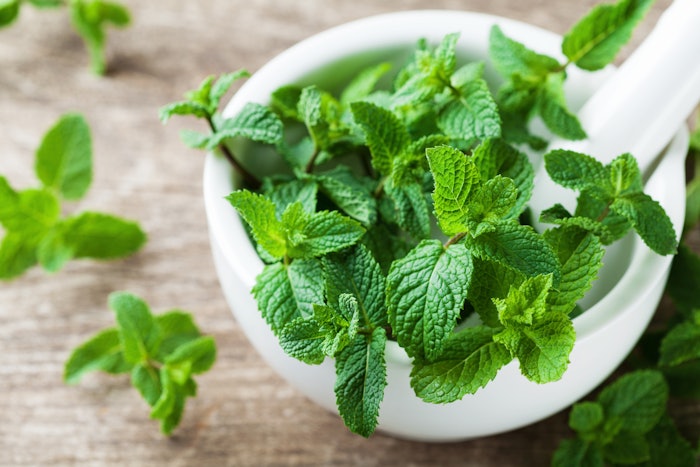
The unmistakable, refreshing sweetness of mint frequently inspires nostalgia. Whether it’s fond memories of holiday candies, ice cream on a hot day or the iconic taste of a brand’s signature product, mint is a stimulating flavor that’s familiar, timeless and comforting.
Creating superior mint flavor starts at the source. From more than 600 cultivars of mint, over 95% of all commercial mint oil is derived from four Tim Nemeth, principal scientist, ADMCourtesy of ADM
Tim Nemeth, principal scientist, ADMCourtesy of ADM
Each growing district can provide a distinct profile to a peppermint or spearmint character, much like specific regions develop unique qualities in wine. These nuances can create mint oils that define a signature flavor found only in specialty products. For example, peppermint grown in Idaho or the Kennewick region of Washington state can take on more green, earthy, furan and sweet mentholic properties. Other innate compounds like isovaleraldehyde, 2-methyl butanol and methional enhance chocolate characteristics, while peppermint grown in Oregon’s Willamette valley will feature more rich, herbaceous and bold ketonic notes.
Every year it’s becoming more challenging to source and supply these district-specific mint oils. Pressures from competing crops, disease, loss of agricultural ground and legacy growers aging out of the business continually threaten the existence of these growing districts. Furthermore, mint agricultural crops are grown in regions confronted with consistently changing environmental factors, water restrictions, soil erosion and other challenges. To overcome these stressors, mint farmers and scientists are working hand in hand to preserve quality and ensure reliable yields and authentic, enjoyable mint flavors are available for generations to come.
Mint Innovation Takes Root
In the mid-1800s, US mint production was mainly in Midwestern states. Then, in the 1950s, a fungal disease called Verticillium wilt took over mint Mint has traditionally been used in confectionery, dairy treats and baked goods.Postmodern Studio at Adobe Stock
Mint has traditionally been used in confectionery, dairy treats and baked goods.Postmodern Studio at Adobe Stock
While Verticillium wilt and other crop diseases have an ongoing effect on mint harvests, scientific advancements are helping to circumvent these concerns. Researchers are driven to understand the mechanisms within the mint genome that promote disease resilience between different mint cultivars and produce desirable molecular attributes and agronomic traits through non-GMO breeding techniques. Some may screen varietals for plant stress hormones that could lead to indicators of drought tolerance, or study mint varietals that have deeper root anatomy to withstand and sustain low or restricted water scenarios.
Though plant resilience is key, a successful crop also must provide consistent qualities, reliable yields and stable supply, year after year. It’s also important to do so with minimal environmental impact. Plants with greater disease resistance might mean that farmers can use less water or fertilizer for their crop since they can propagate mint on wilt-infected fertile fields. It might also allow farmers to reclaim land infected with Verticillium wilt and improve soil health by extending plantation life of their mint fields. This combination of sustainability and innovation is essential to the next generation of mint crops.
Exceptional Mint Extracts & Oils
After the harvest comes the next point of mint flavor differentiation – standardizing from crop to crop and season to season to ensure consistent flavor, aroma and quality. Mint oil rectification aids in improving mint oil quality using traditional vacuum and steam distillation techniques. In addition to legacy distillation techniques, newer technology uses continuous distillation for an element of efficiency and takes a gentler approach to heating mint oils. Rectifying a mint oil helps to reduce some of the undesirable top and field note characteristics like sulfur, weedy and fruity green-producing molecules, providing a cleaner, more refined product.
Although flavorists and product developers may find value in both naturals and synthetics, there is no substitute for real mint. Mint essential oils are very complex, containing hundreds of individual molecules that drive incredible nuance. This complexity is nearly impossible to replicate. Mint is also known for its natural cooling sensation, caused by the organic compound menthol. Again, while synthetic options are available, natural cooling ingredients may be preferred. Not only do certain artificial ingredients face marketplace hurdles, but many shoppers are also seeking out naturals on ingredient labels.
The art and science of flavor creation helps capture the full spectrum of mint characteristics. Natural mint blends and flavors are hand-crafted by experts to create intricate sensory experiences that consumers are sure to remember.
An Unforgettable Sensory Experience
Mint can be a polarizing flavor, with some finding it overwhelming in foods and beverages, so it’s necessary for flavorists and formulators to perfect their application rates. At just the right amount, peppermint adds an element of cool refreshment and spearmint delivers a soothing sweetness without overpowering a product. Mint has traditionally been used in confectionery, dairy treats and baked goods. Surprisingly, mint is still considered an emerging flavor in the beverage space.
 When formulating beverages, flavorists may find that a water-soluble mint extract is preferable to terpene-less mint options.MRSUTIN at Adobe Stock
When formulating beverages, flavorists may find that a water-soluble mint extract is preferable to terpene-less mint options.MRSUTIN at Adobe Stock
Mint has even more delicious potential in other types of applications, so it’s encouraging to see flavorists, culinary artists and chefs being adventurous and exploring new options. Influence from Middle Eastern, north African, Mediterranean and southeast Asian cuisines is bringing mint to more savory dishes, such as grilled lamb chops with cilantro mint chutney; mint pesto made with walnuts, fresh mint, olive oil and feta cheese; Vietnamese spring rolls stuffed with fresh mint, rice noodles, lettuce, carrot, cucumber, pork belly and shrimp; and roasted artichoke hearts with parsley and mint.
From a consumer perspective, mint is perceived as a “mood food,” with attributes both invigorating and relaxing. Consumers may turn to the fresh, bold taste of peppermint for a sense of renewed focus and mental clarity, while spearmint is perceived to have calming properties for the mind, which is thought to assist with sleep or stress relief. Mint is also linked to support for digestive health. This range of associations to physical and emotional well-being and mint’s versatile flavor profile enable an amazing opportunity for brands to guide consumers to products that nourish their mind and body.
Sustaining the Future of Mint
Mint will always be faced with challenges, from threats of disease and declining availability of growing district oils to changing market and regulatory conditions. These factors put pressure on brands to maintain the quality and cost of their mint-flavored products.
Innovation is key to ease these pressures. Agronomy is dedicated to finding stronger yielding mint varietals with desirable traits and attributes, and unique mint cultivars with the ability to produce high-value raw materials at high concentrations. Growers are embracing land management practices that reduce the environmental impact of mint cultivation. Their commitment to the land and quality mint crops go back generations and, with ongoing advancements, the industry can continue to support this for generations to come.










